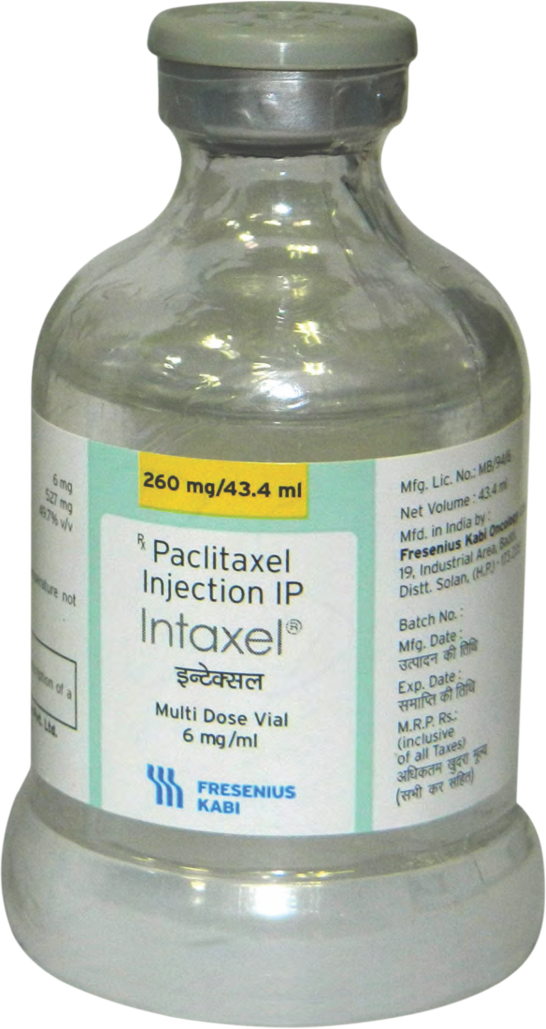- Paclitaxel is a mitotic inhibitor.
- Paclitaxel is a novel antimicrotubule agent that promotes the assembly of microtubules from tubulin dimers and stabilizes microtubules by preventing depolymerization. This stability results in the inhibition of the normal dynamic reorganization of the microtubule network that is essential for vital interphase and mitotic cellular functions. In addition, paclitaxel induces abnormal arrays or "bundles” of microtubules through out the cell cycle and multiple asters of microtubules during mitosis.
Intaxel
- Features
- Indication
- Dosage
- Productinfo
- Paclitaxel Injection (INTAXEL) is indicated as first-line and subsequent therapy for the treatment of advanced carcinoma of the ovary. As first-line therapy, Paclitaxel Injection is indicated in combination with cisplatin.
- Paclitaxel Injection (INTAXEL) is indicated for the adjuvant treatment of node-positive breast cancer administered sequentially to standard doxorubicin-containing combination chemotherapy.
- Paclitaxel Injection (INTAXEL) is indicated for the treatment of breast cancer after failure of combination chemotherapy for metastatic disease or relapse within 6 months of adjuvant chemotherapy. Prior therapy should have included an anthracycline unless clinically contraindicated.
- Paclitaxel Injection (INTAXEL) in combination with cisplatin, is indicated for the first-line treatment of non-small cell lung cancer in patients who are not candidates for potentially curative surgery and/or radiation therapy.
- Paclitaxel Injection (INTAXEL) is indicated for the second-line treatment of AIDS- related Kaposi’s sarcoma.
- Intaxel - Paclitaxel 30 mg/5 ml
- Intaxel - Paclitaxel 100 mg/16.7 ml
- Intaxel - Paclitaxel 260mg/43.4 ml
All patients should be premedicated prior to INTAXEL administration in order to prevent severe hypersensitivity reactions. (See ‘Premedication Regimens’ below).
- Ovarian Cancer:
For previously untreated patients with carcinoma of the ovary, one of the following recommended regimens may be given every 3 weeks.
Paclitaxel administered intravenously over 3 hours at a dose of 175 mg/m2 followed by cisplatin at a dose of 75 mg/m2;
Paclitaxel administered intravenously over 24 hours at a dose of 135 mg/m2 followed by cisplatin at a dose of 75 mg/m2
In patients previously treated with chemotherapy for carcinoma of the ovary, paclitaxel Injection has been used at several doses and schedules; however, the optimal regimen is not yet clear. The recommended regimen is paclitaxel 135 mg/m2 or 175 mg/m2 administered intravenously over 3 hours every 3 weeks.
- Breast Cancer:
For the adjuvant treatment of node-positive breast cancer, the recommended regimen is paclitaxel, at a dose of 175 mg/m2 intravenously over 3 hours every 3 weeks for four courses administered sequentially to doxorubicin-containing combination chemotherapy. The clinical trial used four courses of doxorubicin and cyclophosphamide.
After failure of initial chemotherapy for metastatic disease or relapse within 6 months of adjuvant chemotherapy, paclitaxel at a dose of 175 mg/m2 administered intravenously over 3 hours every 3 weeks has been shown to be effective.
- Non-Small Cell Lung Cancer:
For patients with non-small cell lung carcinoma, the recommended regimen, given every 3 weeks, is paclitaxel administered intravenously over 24 hours at a dose of 135 mg/m2 followed by cisplatin, 75 mg/m2.
- AIDS-related Kaposi’s Sarcoma:
For patients with AIDS-related Kaposi’s sarcoma, paclitaxel administered at a dose of 135 mg/m2 given intravenously over 3 hours every 3 weeks or at a dose of 100 mg/m2 given intravenously over 3 hours every 2 weeks is recommended (dose intensity 45-50 mg/m2/week
- Paclitaxel Injection (Intaxel) is available as 30 mg/5ml, 100 mg/17ml and 260 mg/43.4 ml vials individually packaged in a carton.
- For the use only of a Registered Medical Practitioner or a Hospital or a Laboratory
